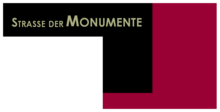Street of the Monuments
Street of the Monuments |
The Street of the Monuments is a network of German monuments and places of remembrance in Central and Eastern Germany founded in 2008 on the initiative of the Leipzig City History Museum . The aim of the network is "to network the places of remembrance as former focal points of the past more closely and to make them more tangible as a whole through joint marketing measures".
The Street of the Monuments currently includes the following seven monuments: the Hermannsdenkmal in Detmold , the Kaiser Wilhelm Monument at Porta Westfalica (both in North Rhine-Westphalia ), the Kyffhäuser Monument in Steinthaleben and the Wartburg near Eisenach (both in Thuringia ), the Navy -Ehrenmal Laboe ( Schleswig-Holstein ), the Berlin Victory Column and the Völkerschlachtdenkmal in Leipzig ( Saxony ).
The monuments
Hermannsdenkmal
The Hermannsdenkmal is located near Hiddesen near Detmold in the southern Teutoburg Forest .
It is intended to commemorate the Cheruscan prince Arminius and the so-called battle in the Teutoburg Forest , in which Germanic tribes under the leadership of Arminius (Latin; in German: Hermann, Armin and also Irmin (Old Low German)) the Roman legions XVII , XVIII and XIX inflicted a crushing defeat under Publius Quinctilius Varus in 9 AD.
The construction of the 53.46 meter high Hermann Monument began in 1838. In 1846 the base of the monument was completed. In the reaction phase after the revolution of 1848, construction was suspended until 1863. The monument project only became popular again with the establishment of the German Empire after the Franco-Prussian War (1870–1871). Both the new German Reichstag and Kaiser Wilhelm I finally enabled the building to be inaugurated with large donations in 1875.
Kaiser Wilhelm Monument
The Kaiser Wilhelm Monument was erected in honor of Kaiser Wilhelm I by the then Prussian Province of Westphalia in 1892–1896 on the eastern flank of the Wittekindsberg at Porta Westfalica . The architect of the monument was Bruno Schmitz . The sculptor Kaspar von Zumbusch designed the imperial statue .
Kyffhäuser Monument
The Kyffhäuser Monument , also known as Barbarossa Monument or Kaiser Wilhelm Monument , is a Kaiser Wilhelm monument on the summit of the Kyffhäuserberg on the eastern edge of the former Reichsburg Kyffhausen . It is located in the district of Steinthaleben near Bad Frankenhausen and was built from 1890 to 1896 in honor of Kaiser Wilhelm I. It is the third largest monument in Germany after the Völkerschlachtdenkmal in Leipzig and the Kaiser Wilhelm monument at Porta Westfalica.
Marine Memorial
The Laboe naval memorial was built as a memorial to the German marines who died in the First World War . The memory of the members of the Navy who fell in World War II was added later. Since it was taken over by the German Navy Federation on May 30, 1954, the memorial commemorates the seamen of all nations who have remained at sea and admonishes peaceful seafaring on the open seas.
Together with the nearby U 995 museum submarine, the Laboer Memorial attracts numerous visitors - between 1954 and 2004, more than 14 million people visited the monument.
Victory Column
The Victory Column on the Great Star in the middle of the Great Tiergarten in Berlin was built from 1864 to 1873 as a national monument to the Wars of Unification based on a design by Heinrich Strack .
The reason for the construction of a victory column was the victory of Prussia in the German-Danish War of 1864. Within a few years two more victorious wars followed, the German War of 1866 against Austria and the Franco-German War of 1870/1871. These three victories were remembered by their original three segments and the crowning bronze sculpture of Victoria .
Dedicated to the Victory Column in celebration of was Sedan Day on September 2, 1873 the third anniversary of the victorious Battle of Sedan . In 1938/1939, as part of Albert Speer's plans for the redesign of Berlin , the column was moved from Königsplatz to its current location on the Großer Stern and increased by a fourth segment.
Völkerschlachtdenkmal
The Völkerschlachtdenkmal was erected in memory of the Völkerschlacht near Leipzig based on designs by the Berlin architect Bruno Schmitz (1858-1916) and inaugurated in 1913. The sculptures were designed by the sculptors Christian Behrens (1852–1905) and Franz Metzner (1870–1919).
It is the largest monument in Europe, thus even higher than the Mother-Homeland statues in Kiev and Volgograd and one of Leipzig's most famous landmarks. It forms a landmark with a distinctive silhouette that is visible from afar . Today it is a branch of the Leipzig City History Museum .
Wartburg
The Wartburg is a castle above the city of Eisenach, at the north-western end of the Thuringian Forest . It was founded by Ludwig the Springer around 1067 and has been a World Heritage Site since 1999 .
Today's Wartburg was largely rebuilt in the 19th century using less preserved parts. The current appearance of the Wartburg and its landscape park goes back to the Grand Duke Carl Alexander von Sachsen-Weimar-Eisenach.
Individual evidence
- ^ City History Museum Leipzig: Street of the Monuments , accessed on March 3, 2011
- ↑ D. Hartwig in Northern Lights: Historical consciousness and historical myths north of the Elbe. , P. 415.








